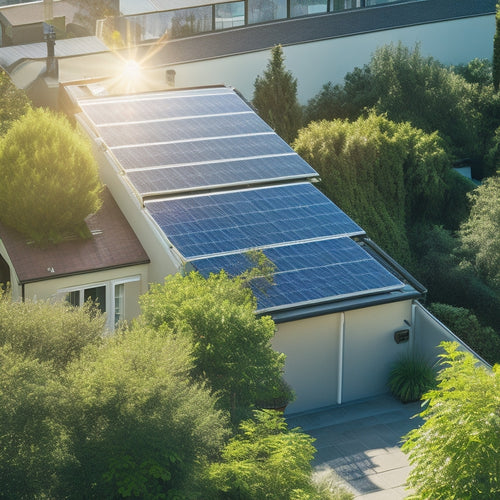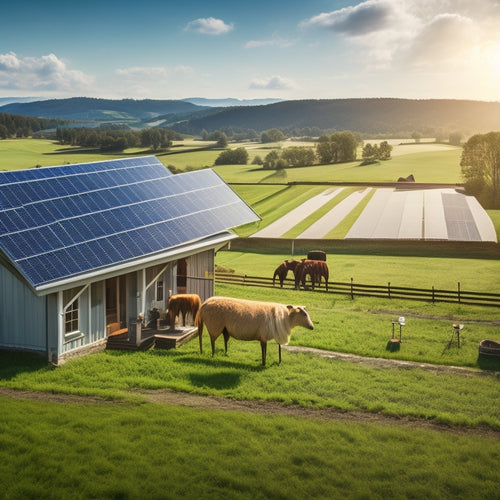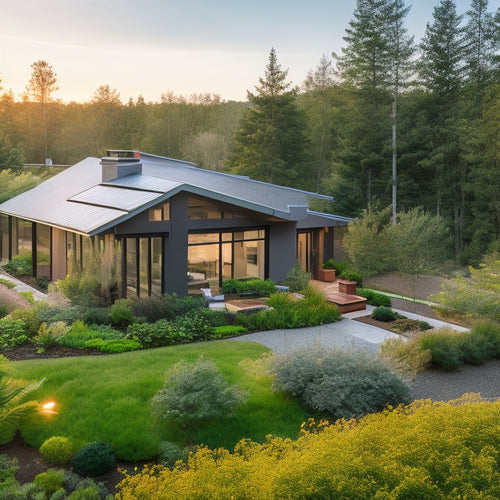Crafting a Greener Kitchen: Sustainable DIY Projects for the Home
Share
You can transform your kitchen into a sustainable haven with creative DIY projects that reduce waste and promote eco-friendliness. Repurpose kitchen waste into compost, baskets, or jewelry, reducing landfill contributions and creating unique items. Upcycle old materials into functional storage solutions, shelves, and cabinets, minimizing waste and promoting sustainable living. Explore eco-friendly countertop alternatives, energy-efficient lighting, and natural decor options to create a truly green kitchen. And, as you dive deeper, you'll uncover even more innovative ways to craft a greener kitchen that's both environmentally conscious and beautifully yours.
Key Takeaways
• Compost Crafts and Waste Weaving transform kitchen scraps into nutrient-rich soil amendments and functional items like baskets and jewelry.
• Repurposing kitchen waste into unique, eco-friendly items reduces landfill contributions and promotes sustainable living.
• Eco-friendly storage solutions like reclaimed shelves and upcycled cabinets minimize waste and reduce the need for new materials.
• Concrete overlays and recycled glass countertops offer sustainable alternatives to traditional materials, reducing waste and environmental harm.
• Energy-efficient lighting options, such as Energy Harvesting technology and Smart Fixtures, reduce carbon footprint and energy consumption.
Repurposing Kitchen Waste Creatively
By creatively repurposing kitchen waste, you can reduce your environmental footprint and uncover a treasure trove of reusable materials hiding in plain sight.
One innovative approach is Compost Crafts, where food scraps are transformed into nutrient-rich soil amendments. You can create a thriving compost heap by layering kitchen waste with leaves, twigs, and other organic matter. As the mixture breaks down, you'll be left with a natural fertilizer perfect for nourishing your garden or houseplants.
Another creative outlet is Waste Weaving, where discarded materials are transformed into functional items like baskets, mats, or even jewelry. By upcycling kitchen waste, you'll not only reduce landfill contributions but also produce unique, eco-friendly items for personal use or gifting.
For instance, you can weave fruit and vegetable peels into a sturdy basket or turn old tea bags into a one-of-a-kind piece of jewelry. By embracing these creative approaches, you'll not only minimize waste but also tap into a world of sustainable possibilities.
Sustainable Storage Solutions Abound
You can redefine traditional storage methods with sustainable solutions that not only reduce waste but also add a touch of eco-friendly charm to your home or workspace.
By incorporating reclaimed shelves and upcycled cabinets, you'll not only reduce landfill waste but also create a unique, one-of-a-kind storage system. For example, consider repurposing old pallets to create rustic shelving units or transforming vintage suitcases into quirky storage cabinets.
You can also give new life to old furniture by refinishing or repainting it, reducing the need for new, resource-intensive materials.
Additionally, consider using eco-friendly materials like bamboo, recycled metal, or sustainably sourced wood for your storage solutions. These alternatives not only reduce waste but also promote sustainable forestry practices.
Eco-Friendly Countertop Alternatives
Swap traditional countertops for eco-friendly alternatives that not only reduce environmental harm but also add a touch of sophistication to your kitchen or bathroom.
You can opt for concrete overlays, which are made from a mixture of cement, water, and aggregate, reducing the need for new materials and minimizing waste. This sustainable option can be customized to fit your style, from modern to rustic, and can be applied over existing countertops, reducing the need for demolition.
Another eco-friendly option is recycled glass countertops, which are made from post-consumer glass waste, such as bottles and jars. This innovative material not only reduces landfill waste but also adds a unique, sparkly touch to your kitchen or bathroom.
You can choose from a variety of colors and textures, making it easy to match your desired aesthetic. By choosing eco-friendly countertops, you're not only reducing your environmental footprint but also creating a stunning, one-of-a-kind space that reflects your commitment to sustainability.
Lighting the Way to Efficiency
As you navigate the world of sustainable DIY projects, upgrading to energy-efficient lighting is a pivotal step in reducing your carbon footprint.
By making the switch to eco-friendly lighting options, you'll not only lower your energy consumption but also create a healthier and more sustainable kitchen environment.
Consider incorporating Energy Harvesting technology, which captures and converts natural light into electricity, reducing your reliance on traditional energy sources.
Another innovative solution is the installation of Smart Fixtures, equipped with sensors that adjust brightness and color temperature according to the time of day and ambient light.
These fixtures can be programmed to optimize energy efficiency, providing the perfect balance of illumination and sustainability.
By choosing energy-efficient lighting options, you'll reduce your energy consumption, lower your electricity bills, and contribute to a greener future.
Greening Your Kitchen Decor
By incorporating eco-friendly materials and repurposing vintage items, you can breathe new life into your kitchen decor while reducing waste and minimizing environmental impact.
You can start by swapping out synthetic materials for natural accents like woven baskets, reclaimed wood, and living plants. These elements won't only purify the air and create a calming atmosphere but also add warmth and character to your kitchen.
To infuse your space with vintage charm, scour thrift stores, garage sales, or your grandmother's attic for unique, one-of-a-kind pieces.
Repurpose old windows as decorative wall hangings or turn vintage apothecary jars into rustic storage containers. You can also upcycle old furniture, like turning an antique door into a kitchen island or using an old ladder as a makeshift shelving unit.
Frequently Asked Questions
How Do I Properly Clean and Maintain My DIY Kitchen Projects?
To keep your DIY kitchen projects looking their best, incorporate daily routines like wiping down surfaces and cleaning up spills immediately, and schedule seasonal refreshes to deep clean and reorganize your space.
What Are Some Eco-Friendly Alternatives to Traditional Kitchen Cleaners?
You can ditch harsh chemicals for natural soaps and eco-friendly disinfectants, like white vinegar and baking soda, that effectively clean and sanitize your kitchen without harming the environment or your health.
Can I Use Reclaimed Wood for My DIY Kitchen Renovation?
You can definitely use reclaimed wood for your DIY kitchen renovation, embracing the reclaimed beauty of salvaged materials. Guarantee responsible wood sourcing by choosing suppliers that prioritize sustainability and transparency in their harvesting practices.
Are Composting Toilets a Viable Option for the Kitchen?
You're considering composting toilets for your kitchen, a great step towards water conservation and efficient waste management, as they reduce water usage and turn waste into nutrient-rich fertilizer, making them a viable eco-friendly option.
How Can I Involve My Children in Sustainable Kitchen DIY Projects?
You can engage your kids in sustainable kitchen DIY projects through kid-friendly crafts, fostering family bonding and eco-awareness. Start with simple tasks, like decorating reusable bags or creating a recycling chart, to instill a sense of responsibility and teamwork.
Related Posts
-

How Solar Panels Reduce Electricity Bills
Solar panels can drastically cut your electricity bills by utilizing sunlight to generate your own energy. This decre...
-

Solar Power Systems for Rural Properties
Solar power systems offer a reliable and efficient energy solution for rural properties, allowing you to gain energy ...
-

Sustainable Home Design for Reduced Carbon Footprint
Sustainable home design is your pathway to a smaller carbon footprint and a healthier living space. By incorporating ...


